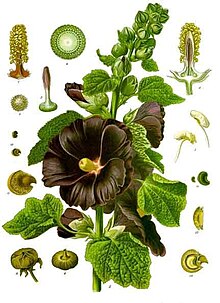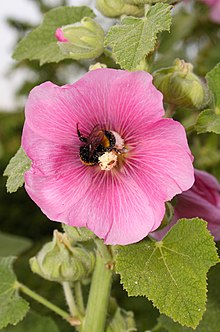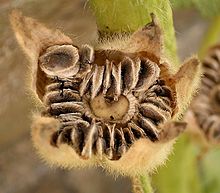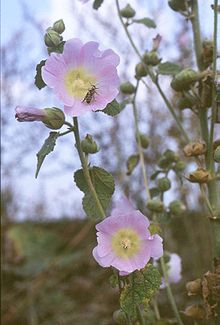Hollyhocks
| Hollyhocks | ||||||||||||
|---|---|---|---|---|---|---|---|---|---|---|---|---|

Hollyhock ( Alcea rosea ) |
||||||||||||
| Systematics | ||||||||||||
|
||||||||||||
| Scientific name | ||||||||||||
| Alcea | ||||||||||||
| L. |
The hollyhocks also hollyhock mallow ( Alcea ) are a genus of plants in the family of the mallow plants (Malvaceae). The approximately 60 species are distributed in Eastern and Southern Europe, Southwest and Central Asia. Some varieties are used as ornamental plants .
description




Vegetative characteristics
In Alcea TYPES is upright, single, biennial or short-lived perennial, herbaceous plants . The vegetative parts of the plant are covered with star hairs ( trichomes ), sometimes also with long, simple hairs. In the first year they only form a rosette of basal leaves . In the second year they form a 1 to 3 meter high, more or less unbranched, upright stem with alternate leaves that ends with the inflorescence . The leaves are divided into long petioles and leaf blades. The leaf blade is ovate to rounded and, depending on the species, slightly lobed to deeply divided. The leaf margin is crenate or toothed. There are stipules present.
Generative characteristics
The flowers stand individually or in groups in the leaf axils and often result in a long racemose inflorescence .
The large flowers are radial symmetry , hermaphroditic, five-fold with double perianth . The six or seven sepals are only fused at their base. The five fluffy hairy sepals are fused. The five free petals, which are white, yellow or pink to purple in the wild species, are usually more than 3 cm wide.
The compact anthers are yellow. Of from 15 or more carpels intergrown ovary consists of 15 or more chambers each with a single ovule . There are as many stamens as carpels. In the subfamily Malvoideae, the many stamens have grown together to form a tube surrounding the pistil , the so-called Columna .
The disc-shaped split fruit breaks down into at least 15 bald or downy hairy partial fruits. The seeds are bare or have pustules.
Dissemination and use
The genus occurs in Central Asia and Asia Minor to the eastern Mediterranean region.
Varieties of some species are cultivated in all temperate and subtropical areas of the world. The most common varieties of hollyhock ( Alcea rosea ) are cultivated. Due to the unclear species delimitation, however, other cultivated species are often referred to as Alcea rosea .




Systematics
The genus Alcea was first published in 1753 by Carl von Linné in Species Plantarum . Alcea rosea L. was established as the lectotype species in 1929 by Albert Spear Hitchcock and Jesse Robinson Green in Standard-species of Linnaean Genera of Phaneogams . The genus Alcea belongs to the tribe Malveae in the subfamily of Malvoideae within the family of Malvaceae .
There are around 60 species of Alcea (selection):
- Alcea abchazica Ilyin : Georgia.
- Alcea acaulis (Cav.) Aleph. : It occurs in Egypt and Western Asia.
- Alcea apterocarpa (Tchich.) Boiss.
- Pale hollyhock ( Alcea biennis Winterl , Syn .: Alcea pallida (Willd.) Waldst. & Kit. ): The species has its distribution area from Central to Southeastern and Eastern Europe to West Asia.
- Alcea calvertii (Boiss.) Boiss. : It occurs in Turkey and Iran.
- Alcea chrysantha (Sam.) Zohary
- Alcea damascena (Mouterde) Mouterde : It occurs in Syria and Lebanon.
- Alcea digitata (Boiss.) Aleph. : Turkey, Syria, Lebanon and Israel.
- Alcea dissecta (Baker f.) Zohary
- Alcea excubita Iljin : Turkey.
- Alcea fasciculiflora Zohary : Turkey.
- Fig-leaved hollyhock or Dutch hollyhock ( Alcea ficifolia L. ): It is common in Siberia.
- Alcea flavovirens (Boiss. & Buhse) Iljin : The homeland is Iran.
- Alcea galilaea Zohary : It occurs in Israel and in the area of Syria and Lebanon.
- Alcea grossheimii Ilyin :
- Alcea guestii Zohary
- Alcea heldreichii (Boiss.) Boiss. : It occurs only on the Balkan Peninsula and in southern Ukraine.
- Alcea Hohenackeri (Boiss. & A.Huet) Boiss.
- Alcea hyrcana (cap.) Cap.
- Alcea karsiana (Bordz.) Grossh. : Turkey, Georgia and Armenia.
- Alcea kurdica (Schltdl.) Alef. : It occurs in Turkey, Iraq and Iran.
- Alcea lavateriflora (DC.) Boiss. : It occurs in Turkey and elsewhere in Southwest Asia .
- Alcea leiocarpa (Rech. F.) Mouterde : Turkey and Syria.
- Alcea lenkoranica Ilyin
- Alcea litwinowii (Iljin) Iljin : It occurs in Afghanistan and Tajikistan.
- Alcea longipedicellata I. Riedl : It occurs only in Iran.
- Alcea nudiflora (Lindl.) Boiss. : It is common in northwestern Xinjiang , Kazakhstan , Afghanistan , Tajikistan, and Kyrgyzstan .
- Alcea pisidica Hub.-Mor. : Turkey.
- Alcea remotiflora (Boiss. & Heldr.) Alef.
- Common hollyhock ( Alcea rosea L. ), also called hollyhock: It is a one to two year old herbaceous plant of unknown origin.
- Alcea rhyticarpa (Trautv.) Iljin : It occurs in Iran, Afghanistan, Kazakhstan, Turkmenistan and Uzbekistan.
- Yellow Hollyhock or Wrinkled Hollyhock ( Alcea rugosa Alef. ): It is native to southwest Russia and the Ukraine .
- Alcea sachsachanica Ilyin
- Alcea setosa (Boiss.) Aleph. : It occurs in Crete, in the Middle East and in Egypt.
- Alcea sophiae Iljin : Turkey and Armenia.
- Alcea sosnovskyi Iljin : It occurs in Iran and Azerbaijan.
- Alcea striata (DC.) Aleph. : It occurs in Egypt and Western Asia.
- Sulfur yellow hollyhock ( Alcea sulphurea (Boiss. & Hohen.) Alef. ): The homeland is Iraq and Iran.
- Alcea tabrisiana (Boiss. & Buhse) Ilyin
- Alcea transcaucasica (Iljin) Iljin : Armenia and Georgia.
- Alcea turkeviczii Ilyin
swell
- Ya Tang, Michael G. Gilbert, Laurence J. Dorr: In: Wu Zheng-yi, Peter H. Raven, Deyuan Hong (Eds.): Flora of China . Volume 12: Hippocastanaceae through Theaceae . Science Press / Missouri Botanical Garden Press, Beijing / St. Louis 2007, ISBN 978-1-930723-64-1 , Alcea , p. 267 (English, online ). (Sections Description and Distribution)
- David Allardice Webb: Alcea L. In: TG Tutin, VH Heywood, NA Burges, DM Moore, DH Valentine, SM Walters, DA Webb (Eds.): Flora Europaea . Volume 2: Rosaceae to Umbelliferae . Cambridge University Press, Cambridge 1968, ISBN 0-521-06662-X , pp. 253–254 (English, limited preview in Google Book Search).
Individual evidence
- ↑ Gordon Cheers (Ed.): Botanica. The ABC of plants. 10,000 species in text and images . Könemann, Cologne 2003, ISBN 3-8331-1600-5 , p. 72 .
- ↑ Carl von Linné: Species Plantarum. Volume 2, Lars Salvius, Stockholm 1753, p. 687, digitized .
- ↑ Alcea at Tropicos.org. Missouri Botanical Garden, St. Louis, accessed January 6, 2014.
- ↑ a b c d e f g h i j k l m n o p q r Alcea in the Germplasm Resources Information Network (GRIN), USDA , ARS , National Genetic Resources Program. National Germplasm Resources Laboratory, Beltsville, Maryland. Retrieved January 6, 2014.
- ↑ a b c d e f g h i j k l m n o p q r s t u v w x y z aa ab ac ad ae af Benito Valdés: Malvaceae. In: Euro + Med Plantbase - the information resource for Euro-Mediterranean plant diversity . Berlin, 2011.
- ↑ Ya Tang, Michael G. Gilbert, Laurence J. Dorr: In: Wu Zheng-yi, Peter H. Raven, Deyuan Hong (Eds.): Flora of China . Volume 12: Hippocastanaceae through Theaceae . Science Press / Missouri Botanical Garden Press, Beijing / St. Louis 2007, ISBN 978-1-930723-64-1 , Alcea , p. 267 (English, online ).
- ↑ a b c Walter Erhardt , Erich Götz, Nils Bödeker, Siegmund Seybold: The great pikeperch. Encyclopedia of Plant Names. Volume 2. Types and varieties. Eugen Ulmer, Stuttgart (Hohenheim) 2008, ISBN 978-3-8001-5406-7 .
